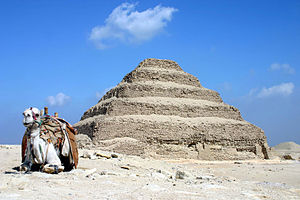Pyramid of Djoser
| Pyramid of Djoser | |
|---|---|
 |
|
| Djoser | |
| Coordinates | 29°52′16.56″N 31°12′59.02″E / 29.8712667°N 31.2163944°ECoordinates: 29°52′16.56″N 31°12′59.02″E / 29.8712667°N 31.2163944°E |
| Constructed | c. 2667–2648 BC (3rd dynasty) |
| Type | Step pyramid |
| Material | Limestone |
| Height | 62 metres (203 ft) |
| Base | 125.27 metres (411 ft) (larger) 109.12 metres (358 ft) (smaller) |
| Volume | 330,400 cubic metres (11,667,966 cu ft) |
The Pyramid of Djoser (or Djeser and Zoser), or step pyramid (kbhw-ntrw in Egyptian) is an archeological remain in the Saqqara necropolis, Egypt, northwest of the city of Memphis. It was built during the 27th century BC for the burial of Pharaoh Djoser by his vizier, Imhotep. It is the central feature of a vast mortuary complex in an enormous courtyard surrounded by ceremonial structures and decoration.
This first Egyptian pyramid consisted of six mastabas (of decreasing size) built atop one another in what were clearly revisions and developments of the original plan. The pyramid originally stood 62 metres (203 ft) tall, with a base of 109 m × 125 m (358 ft × 410 ft) and was clad in polished white limestone. The step pyramid (or proto-pyramid) is considered to be the earliest large-scale cut stone construction, although the pyramids at Caral in South America are contemporary and the nearby enclosure known as Gisr el-mudir would seem to predate the complex.
Djoser was the first or second king of the 3rd Dynasty (ca. 2667 to 2648 BC) of the Egyptian Old Kingdom (ca. 2686 to 2125 BC). He is believed to have ruled for 19 years or, if the 19 years were biennial taxation years, 38 years. He reigned long enough to allow the grandiose plan for his pyramid to be realized in his lifetime.
Djoser is best known for his innovative tomb, which dominates the Saqqara landscape. In this tomb he is referred to by his Horus name Netjeriykhet; Djoser is a name given by New Kingdom visitors thousands of years later. Djoser’s step pyramid is astounding in its departure from previous architecture. It sets several important precedents, perhaps the most important of which is its status as the first monumental structure made of stone. The social implications of such a large and carefully sculpted stone structure are staggering. The process of building such a structure would be far more labor-intensive than previous monuments of mud-brick. This suggests that the state, and therefore the royal government had a new level of control of resources, both material and human. Also, from this point on, kings of the Old Kingdom are buried in the North, rather than at Abydos. Furthermore, although the plan of Djoser’s pyramid complex is different than later complexes, many elements persist and the step pyramid sets the stage for later pyramids of the 4th, 5th, and 6th Dynasties, including the great pyramids at Giza. Finally, another intriguing first is the identification of the architect Imhotep, who is credited with the design and construction of the complex.
...
Wikipedia
